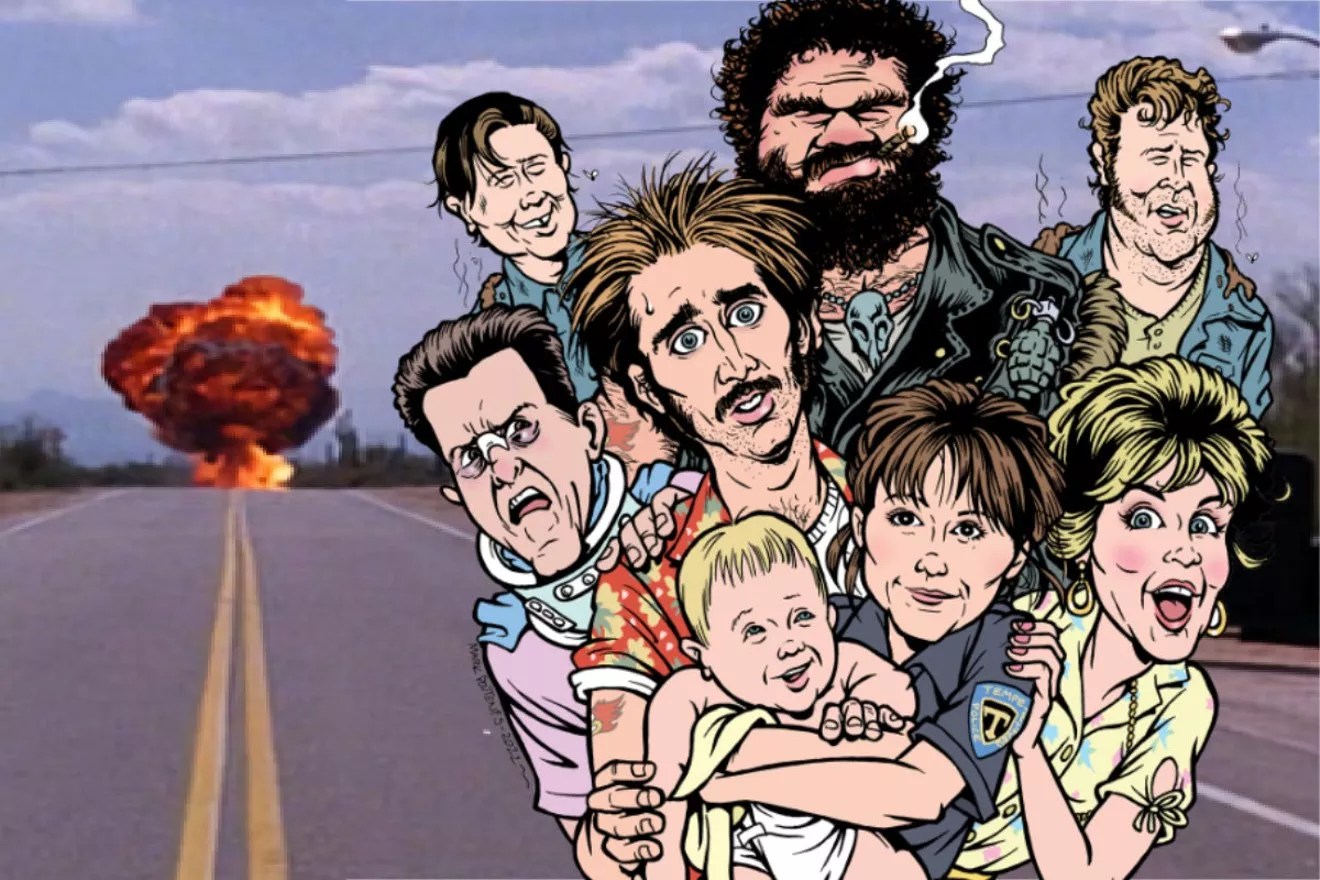
Illustration: Mark Poutenis. Background: Circle Films/20th Century Fox

Audio By Carbonatix
You’ll have to forgive TJ Kuhn if his memories of his big-screen debut in a major motion picture are a little fuzzy. After all, he was only less than a year old at the time.
In 1987, the Valley native played infant Nathan Junior in the screwball comedy crime caper Raising Arizona, sharing the screen with actors Nicolas Cage and Holly Hunter, who starred in the film as a childless couple who kidnapped his character to raise as their own.
The film – released in theaters 35 years ago this week – was written and directed by the brothers Joel and Ethan Coen and was filmed almost entirely in the metro Phoenix area. He landed the role after his parents, residents of the Moon Valley area, responded to a local casting call.
You’d think that appearing alongside a pair of Oscar-winning actors in a now-beloved film directed by two of Hollywood’s most esteemed auteurs would be something that stands out in your mind.
Phoenix, make your New Year’s Resolution Count!
We’re $12,000 away from reaching our $30,000 year-end fundraising goal. Your support could be what pushes us over the top. If our work has kept you informed, helped you understand a complex issue, or better connected you to your community, please consider making a contribution today.
Not so, says Kuhn, who works as a local real estate agent. His father is another story.
“My earliest memories are, everywhere we went, my dad would be the one to tell everybody that I’m the baby from that one movie,” Kuhn says. “So I always knew about it, but I didn’t realize how significant it was until my teens.”
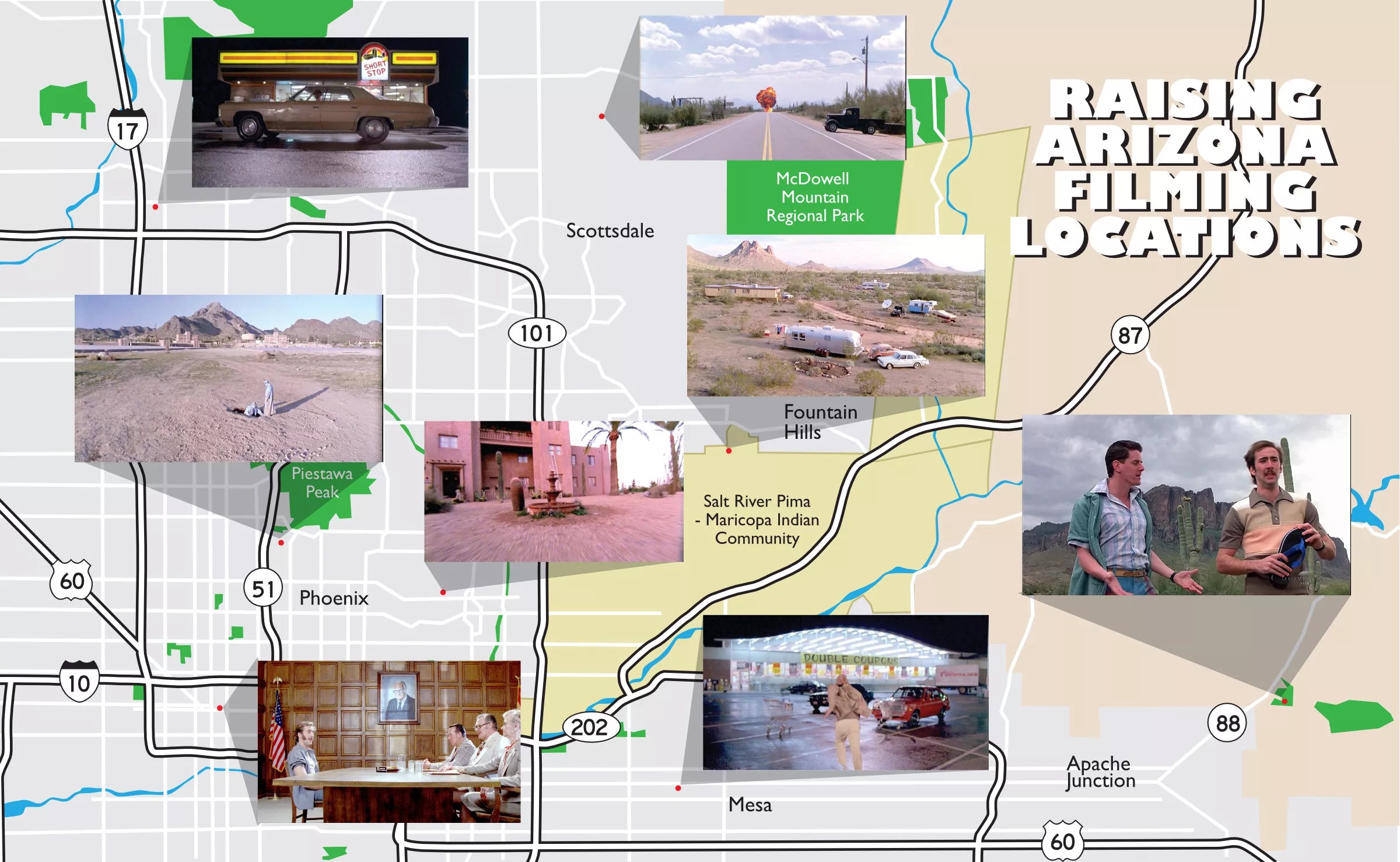
New Times map
By then, Raising Arizona had firmly become entrenched as an all-time classic. Although met with middling reviews and box office returns following its release in March 1987, the film became a cult favorite thanks to its signature Coen quirkiness and oft-quotable lines and found its true audience through home video and cable.
It’s also earned an appreciation among Arizonans, despite the cinematic roasting our state and its residents receive in the film. The sun-scorched romp paints with broad comical brushstrokes, lampooning us as idiosyncratic hayseeds while also celebrating our desert home in a sense. The film is filled with glimpses of local landmarks like Piestewa Peak and the Superstition Mountains.
Chief among the memorable characters is protagonist H.I. “Hi” McDunnough, a goofball recidivist offender with a heart of gold and a yen for armchair philosophy who’s played with doe-eyed perfection by Cage, long before the actor became a walking internet meme. In the film, he marries Edwina (Hunter), the cop he woos with his charms. Unable to conceive on their own, the two hatch a harebrained scheme to kidnap one of the five “Arizona quints” born to Phoenix unpainted furniture tycoon Nathan Arizona. Their plot unravels as the couple has to deal with Gale (John Goodman) and Evelle (William Forsythe), two scheming former prison buddies of Hi’s who have escaped the pen, as well as the terrifying bounty hunter Leonard Smalls, who’s hired to recover Nathan Junior.
Raising Arizona was markedly different from the Coens’ first film, the 1984 Southern-fried crime noir Blood Simple. According to interviews with the brothers, it was intentional, as they were seeking lighter, more offbeat fare.
When the Coens came to the Valley in 1986, they brought a group of character and theater actors from New York and L.A. (including Goodman, Forsythe, Hunter, and Frances McDormand) and a largely East Coast crew, but also drew on talent locally.

The cast and crew of Raising Arizona.
Melinda Sue Gordon
It included local actors like Lynne Kitei, a local physician with a background in musical comedy, as well as production professionals with Valley ties, such as local lighting and electrical tech Bob Field, who was hired along with Danny McCallum and George Ball.
“It was an interesting scenario because there were the New York guys of the film, and we’re local Arizona guys who were also working in L.A.,” Field says. “It was also a mix of union and non-union crews because Arizona’s a right-to-work state.”
Raising Arizona‘s production also gave opportunities to Valley residents who were trying to break into the film industry. Linette Shorr was a recent Arizona State University graduate who was eventually hired as a set dresser.
“I was a huge fan of Blood Simple, and there was something in the Arizona Republic about how [the Coens] were coming to film. So I got as relentless as you are when you really want something, and kept interviewing in every department until the production supervisor, Alma [Kuttruff], kept saying, ‘Yeah, we need you.'”
Connie Hoy, then a film student at Scottsdale Community College, was similarly persistent and was hired as a production assistant.
“I kept showing up and asking to work until they took me on. You’re just a young kid who was getting into the biz and you didn’t want to ask too many questions. I was just a scared little film school student that just wanted to do my job,” she says. “As a PA, you’re doing whatever you can do to help out the crew. When there’s a guy shooting a gun at Nic as he’s running by, after they yell cut, you start sweeping up as they reload.”
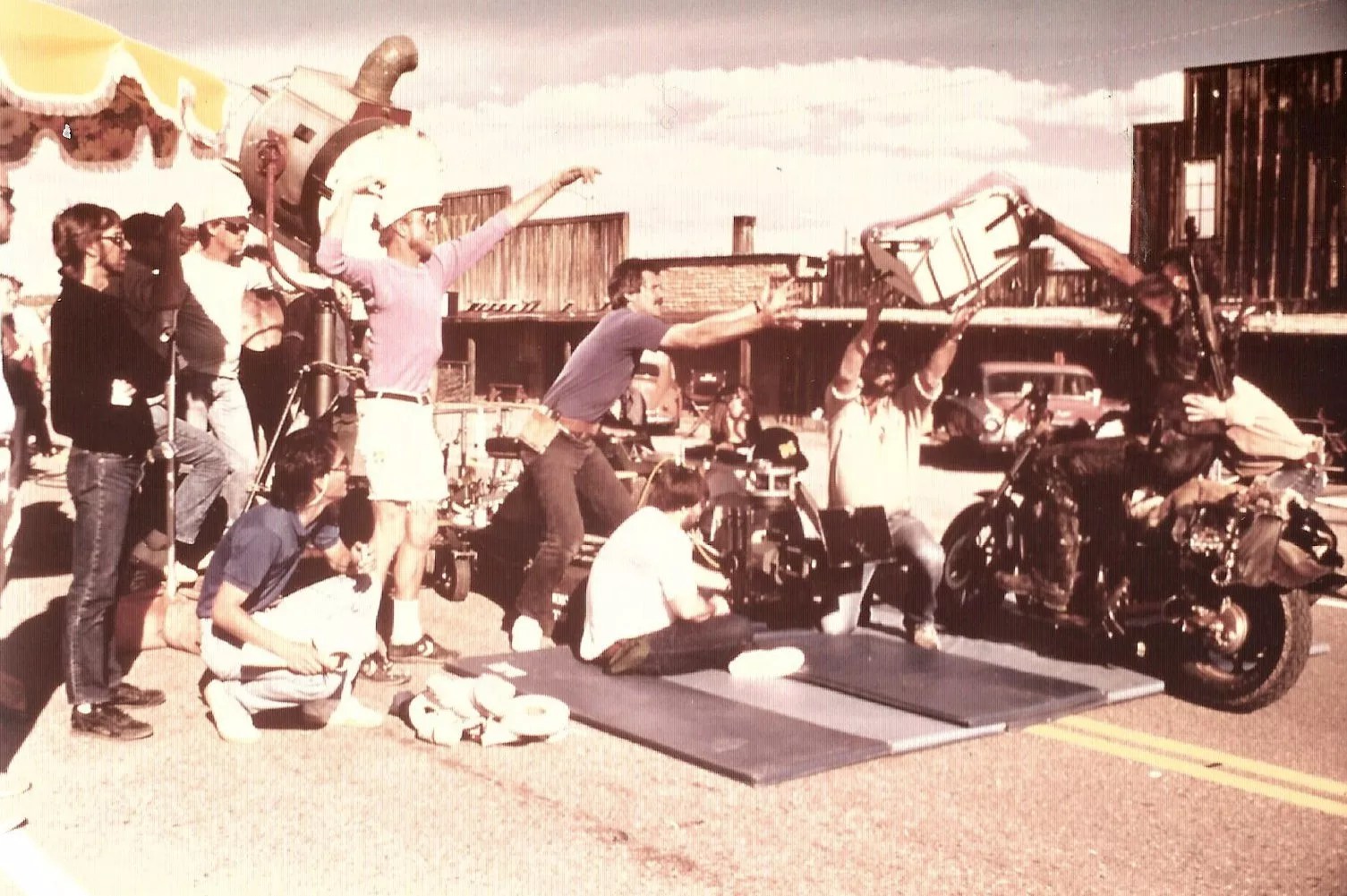
Raising Arizona’s crew filming a scene at the now-demolished Reata Pass Steakhouse in Scottsdale.
Courtesy of Julie Asch Kareus
Debra Knoblauch, who worked on the Phoenix Film Commission for 30 years, remembers taking the brothers location scouting for the film.
“We went around looking and found things that they liked. And then they brought out their art department and location manager and scout again, and kept working together to pin it down,” she says.
Filming on Raising Arizona ran approximately 12 weeks in locations across the Valley, from north Phoenix to Apache Junction, in desert landscapes and old-timey restaurants like the now-demolished Reata Pass Steakhouse in Scottsdale.
Phoenix New Times is taking a tour of many of these same locations used in the film in honor of Raising Arizona‘s 35th anniversary this week. It’s also a trip down memory lane, as we’ve spoken with a number of people involved on both sides of the camera for their recollections from those days.
As H.I. says in the flick, it ain’t Ozzie and Harriet.
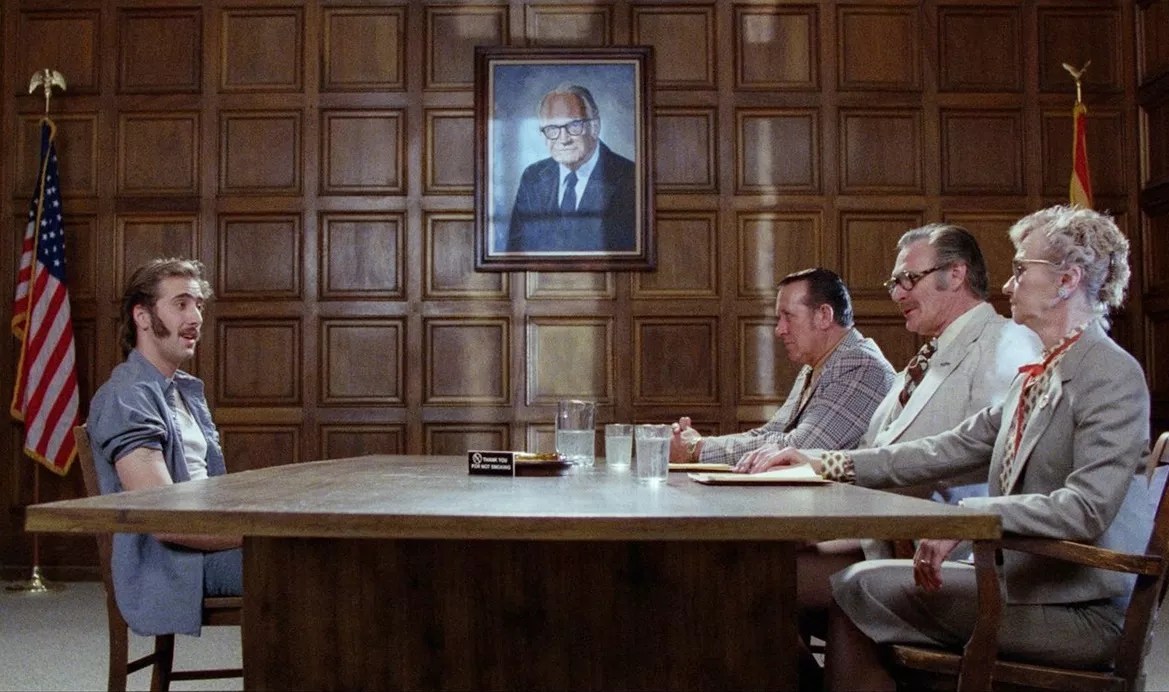
The parole board scene from Raising Arizona.
Circle Films/20th Century Fox
Parole Board, Gynecologist’s Office & Elsewhere
Old Phoenix City Hall, 125 West Washington Street
When Debra Knoblauch began reading Raising Arizona‘s script and saw it called for locations like boardrooms and doctor’s offices, she had a suggestion: downtown Phoenix’s historic City Hall.
Built in 1928, the former courthouse and onetime municipal hub was closed at the time and awaiting renovation, and had a number of official-looking rooms suitable for the Coens’ film. (It’d already been featured in a few movies, including 1981’s Used Cars.)
“So we showed them that as a possibility, and they ended up using that as a cover set for a ton of locations if the weather was bad,” Knoblauch says. “They did the police station, the adoption agency, and a lot of other stuff there.”
Linette Shorr remembers helping prep and decorate shooting locations at historic City Hall for filming.
“It’s a very beautiful sort of Art Deco building and the room where he goes in front of the [parole] board was a beautiful [wooden-walled] room, a very rare find in Phoenix,” she says. “My first day at work was to clean those walls. And I was like, ‘Is this what movie people do? I went to college, I had a degree.’ And when the Coen brothers came walking in, I was thinking, ‘Notice me, put me in a different position.'”
She also recalls how the film’s art director Harold Thrasher gave the parole board room a uniquely Arizona touch.
“I remember he was so pleased because he found this great old portrait of Barry Goldwater to use for those scenes and I helped hang them on the wall,” Shorr says.
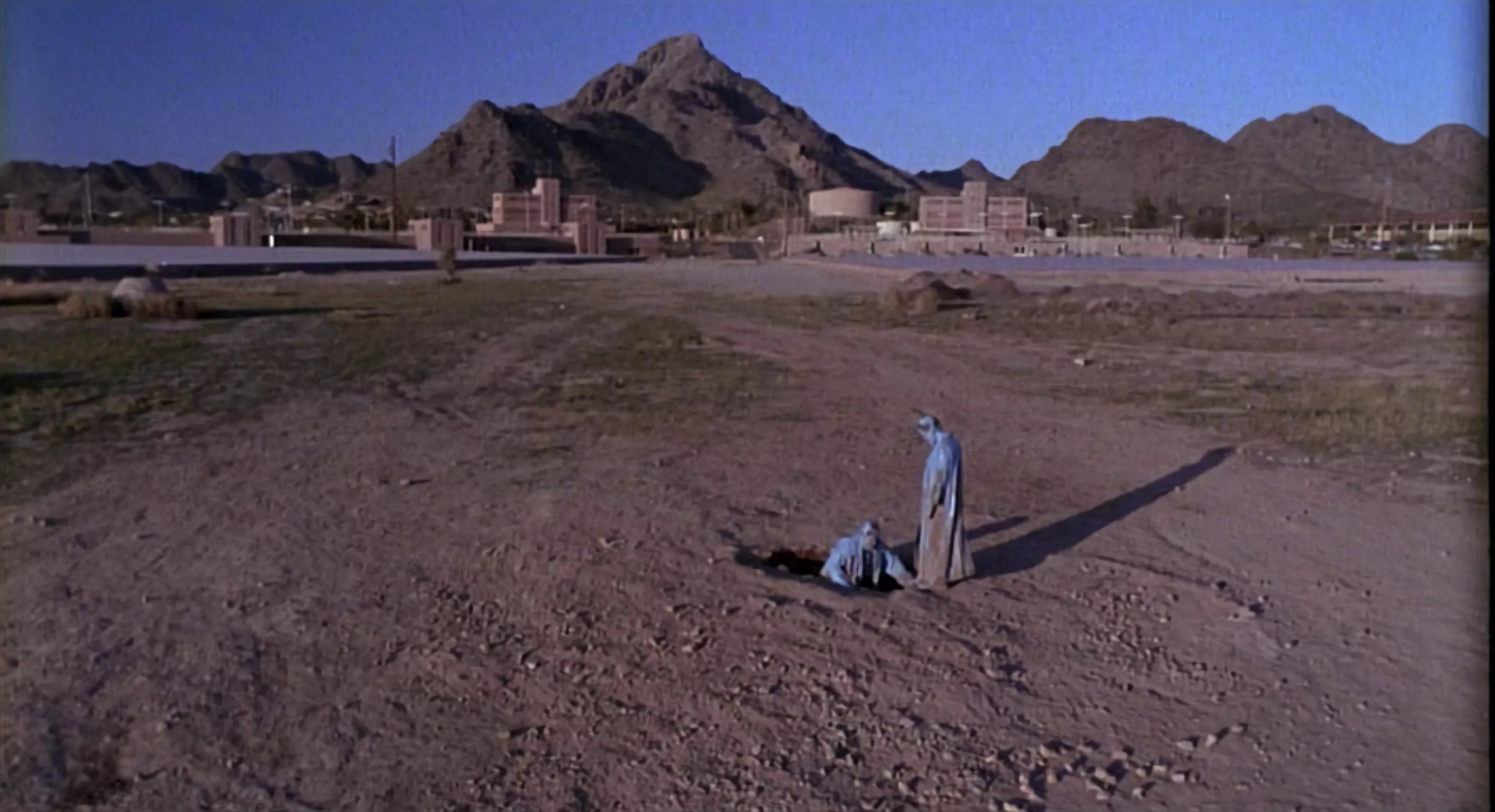
The scene where convicts Gale (John Goodman) and Evell (William Forsythe) return to prison was filmed in north-central Phoenix.
Circle Films/20th Century Fox
Maricopa County Maximum Security Correctional Facility for Men
24th Street Water Treatment Plant, 6202 North 24th Street
“Prison ain’t the easiest place to think …”
For most of its 69-year lifespan, Phoenix’s 24th Street Water Treatment Plant has been an ordinary piece of municipal infrastructure. For a few nights in early 1986, though, it became the exterior of Raising Arizona‘s fictional “Maricopa County Maximum Security Correctional Facility for Men.”
“The Coens were looking for a place to be a prison for a [jail break] scene,” Knoblauch says. “That location looked very stark and turned out to work really well for them.”
It also had a large dirt lot, which was turned into a giant mud pit where convicts Gale (John Goodman) and Evell (William Forsythe) escape by tunneling their way out during a storm. Field says crews dug a hole for a giant inflatable bladder, which supported Goodman and pushed him from the hole.
“He literally stepped out on top of the ground and then pulled [Forsythe] through from his feet,” Field says. “It was just thick and pretty muddy out there to work in, too. It was a clear night, so we had a rain machine going.”
It went better than the production’s experiences at an actual local prison. McCallum says the production had permission to film at the Arizona State Prison Complex in Florence, but only if they’d agree not to bring any prop guns or propane tanks into the facility because of safety concerns.
“So the prop truck breaks down in the middle of the gate on the way into the prison. And they end up looking through the truck and they’re finding guns and propane, which weren’t allowed anywhere near the property,” he says. “And my father [former Arizona Film Commission head William McCallum] got an upset phone call from the warden.”
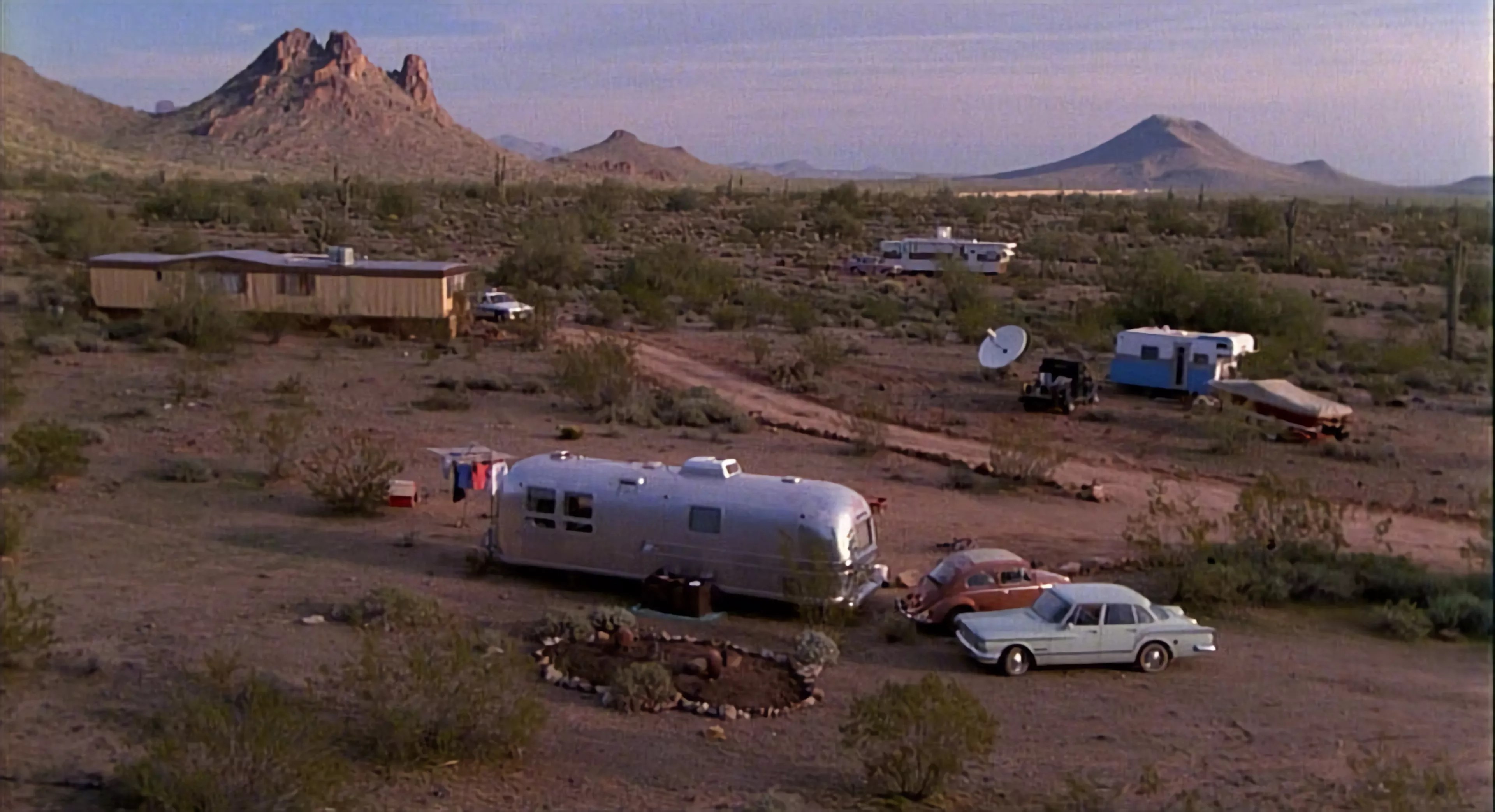
In the film, it’s Tempe. In real life, it’s north Scottsdale.
Circle Films/20th Century Fox
Hi and Ed’s Camper
North 136th Street and East Del Timbre Drive, Scottsdale
“Ed’s pa staked us to a starter home in suburban Tempe …”
Despite Hi’s narration, the couple’s desert homestead and camper weren’t remotely close to Tempe, at least in our universe. Instead, it’s perched on the edge of land owned by the Salt-River Pima Indian Community near the upscale Carino Canyon Homes development. At the time of filming, though, it was essentially the middle of nowhere.
Shorr says they brought in everything to create a cluster of trailers for the movie. “We brought each trailer in and they built the roads. I remember all of us collectively [in the art department] trying to find things and goodies to put in the front yards of each trailer.”
She also wrangled some of the cars parked around the area, including using her own ride.
“I did all the vehicles that were there. My own VW is in front of one of the trailers,” Shorr says. “We were going to leave it up for longer, but there was a time constraint with the deal [the production] had. It’s kind of wild to think about, because that area is now getting built out.”
As for the interior of Hi and Ed’s trailer, that was at another location altogether.
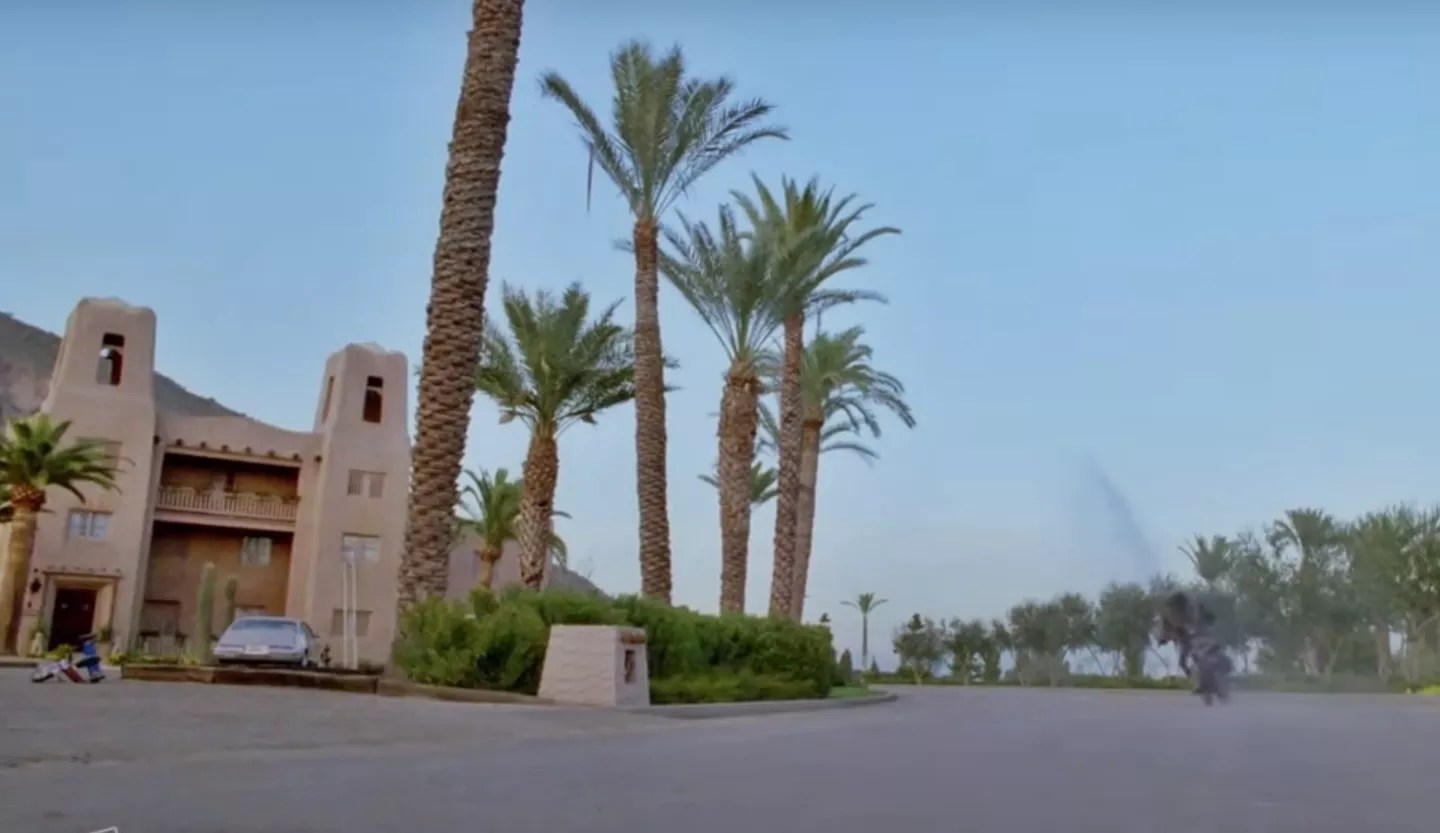
The legendary Jokake Inn at the Phoenician Resort.
Circle Films/20th Century Fox
Arizona Residence
Jokake Inn at The Phoenician, 6000 East Camelback Road, Scottsdale
“You go right back up there and get me a toddler! I need a baby, Hi.”
If you’re an unpainted furniture tycoon like Nathan Arizona, residing in quaint Southwestern digs like the Jokake Inn with your wife and children seems pretty fitting. The historic Pueblo Revival-style adobe dwelling on the grounds of The Phoenician resort fit the movie’s kitschy aesthetic like a turquoise-studded tasseled glove.
Shorr says production had to do extensive landscaping on the property before filming several scenes there, including Hi and Ed kidnapping Nathan Junior from the second-floor window.
“It had been sitting for 20 years or more and nobody had been using it,” she says. “I brought in cactuses and added cactuses to what was already there. And it was just the most beautiful building. It was heaven, like the sort of good bones an [art department] can work with. Jane had this vision of how everything should look.”
The Jokake Inn was only used for exterior scenes of the property; the interiors were filmed at Carefree Studios in north Scottsdale. One sequence that was a mix of both was the low-angle dolly shot where the camera zips along the driveway, up a ladder, through an open window, and into an extreme closeup of Florence Arizona screaming after discovering one of her quints is missing. Field says only the first portion was shot regularly.
“That was a series of many cuts, but in particular, I remember the [sequence] zooming in on Mrs. Arizona’s mouth was shot backward and then played in reverse,” he says.
Lynne Kitei, the actress who played Florence Arizona, says her portion was filmed multiple times and almost went a bit further.
“Once the camera gets into the room, it looks like I turn from the crib and put my hands to my face and then my mouth opens and screams. So I had to act in reverse many times,” she says. “They had the camera zooming all the way into my uvula, like I was Olive Oyl. But that ended up on the cutting room floor, which I’m happy about.”
She says that’s her real three-octave singing voice is heard screaming, though. “That’s all my voice. I must have done that scream 50 times with Barry Sonnenfeld in a big hall.”
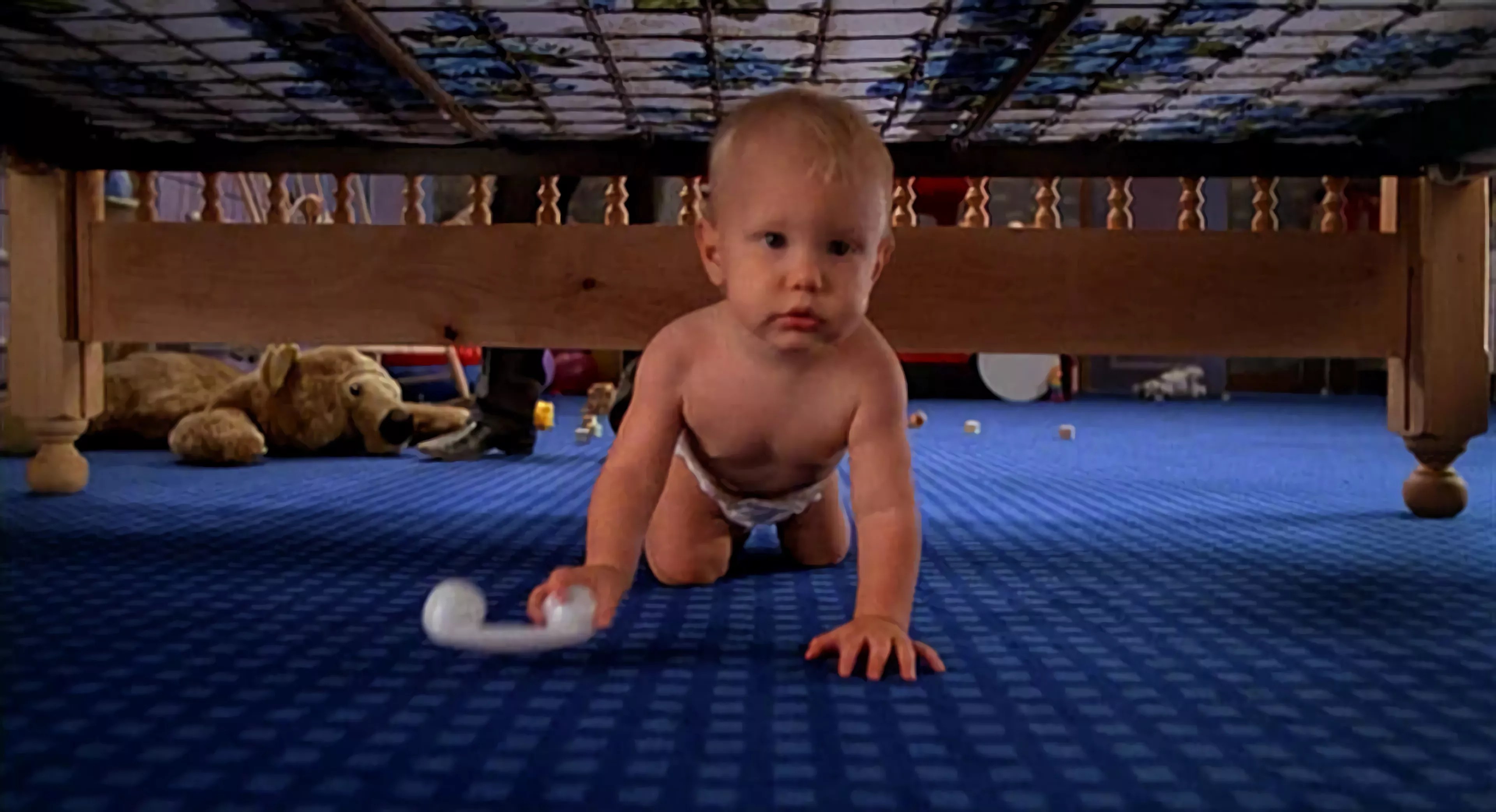
TJ Kuhn as Nathan Arizona.
Circle Films/20th Century Fox
Interior Shots
Carefree Studios, 32331 North Scottsdale Road, Scottsdale
When many movie projects came to the Valley in the ’70s and ’80s, they frequently filmed scenes at the now-demolished Carefree Studios. Raising Arizona is no exception, as scenes inside Hi and Ed’s trailer and other interior locations were shot at the movie ranch on Scottsdale Road north of what’s now Loop 101.
Kitei says two-story sets were created for the Arizonas’ house, and remembers working with Cage on the scene where he kidnaps Nathan Junior.
“I had to walk up all these steps as Nic was grabbing the baby. So we were together a couple of the shoot days,” Kitei says. “He was fantastic to work with.”
Shorr helped with decorating the sets for Hi and Ed’s trailer and the Arizonas’ house and took her cues from art director Harold Thrasher and production designer Jane Musky when it came to the design.
“I remember them talking to me a lot, Jane about her ideas of her idea of things people brought from other places being used on the film because it’s such a transient place, Arizona,” Shorr says. “There’s many generations that have lived here, lasted for a few years, and then leave their objects behind. So it’s sort of like a thrift store aesthetic [for the trailer set].
She was given a blank slate in a sense to decorate both the trailer and the Arizonas’ house.
“With the trailer, they literally said, ‘This is what the carpet will be,’ and then everything else I went and hunted around for. It seemed to be shopping, having me shop and hunt for stuff.”
Scenes involving the Arizona’s nursery were also filmed at the studios. Julie Asch Kareus, an obstetric nurse who was the “baby wrangler” on Raising Arizona, worked with Kuhn and other infants for the film.
“He was the best baby in every aspect,” she says. “He was generic-looking, that’s what Joel [Coen] liked about him. I liked the fact he worked well with me, and was happy.”
Anytime Kuhn appears in the film, Kareus says she’d be just offscreen coaching him, including the memorable scene where Kuhn hides his face with his hooded sweatshirt.
“To get him to do that, I’d pull my hood down, just like we were playing peek-a-boo,” she says.
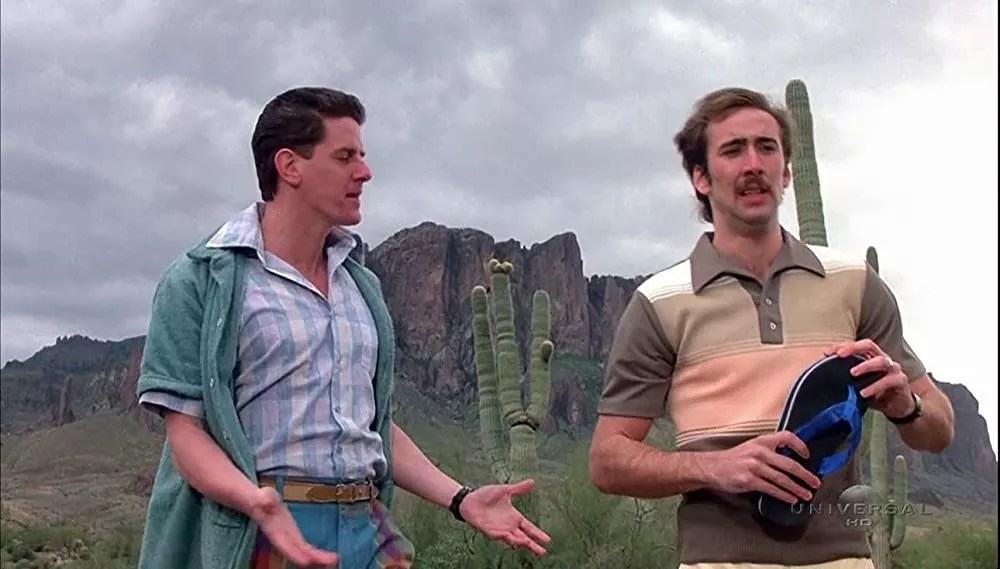
Sam McMurray as Glen (left) and Nicolas Cage as H.I. (right) with the Superstition Mountains in the background.
Circle Films/20th Century Fox
Lost Dutchman State Park
6109 North Apache Trail, Apache Junction “We finally go out with some decent people and you break his nose! That ain’t too funny, Hi”
The picturesque crags and high desert terrain of the Superstition Mountains never looked better than when Raising Arizona cinematographer (and future director) Barry Sonnenfeld shot it for the film. The iconic mountain range was the prominent backdrop for scenes filmed at Lost Dutchman State Park in Apache Junction, including a scene where H.I. decks his lecherous boss Glen while their two families share a picnic.
Field remembers it being beautiful, if not downright chilly, when shooting at the park.
“We were out at the base of the Superstitions one of the first few days of shooting and I remember that afternoon being extremely cold,” he says. “I think they even had to fight to keep from seeing the breath and yet are in T-shirts and Hawaiian shirts.”
If actor Sam McMurray, who played Glen, had any complaints about working in such conditions, he doesn’t mention them when speaking with Phoenix New Times.
“I would say overall that it was the best experience I’ve ever had on a movie shoot,” McMurray says. “The production was spectacularly attuned to actors.”
Short Stop Convenience Store
2311 West Deer Valley Road
“I’ll be taking these Huggies and whatever cash you got.”
One of Raising Arizona‘s most unforgettable (and utterly hilarious) moments comes after H.I. welches on his promise to give up a life of crime. Needing diapers, he sticks up a convenience store while masked with a pair of women’s pantyhose, as his wife and Nathan Junior wait outside in the car. Then, all hell breaks loose.
After witnessing his crime, Ed ditches him in disgust and burns rubber out of the parking lot. Then, the police arrive. And the store’s trigger-happy clerk begins opening fire with a .44 magnum. Cage’s character quickly hotfoots it away with the cops in close pursuit.
What follows is a bonkers chase sequence over the next 20 minutes accentuated by composer Carter Burwell’s devilishly madcap score of banjo music and yodeling. The scenes were filmed across three different Valley cities, McCallum says, including at a now-defunct Short Stop convenience store on Deer Valley Road east of Interstate 17. (The store has since become a Circle K.)
“Shooting the Huggies chase was like three weeks of nights, and we were moving all over town for it,” says. “I remember we had 120-foot-tall [lighting rigs] flying and there was a lot going on.”
Hoy says residents near the Short Stop thought an actual crime was in progress. “Someone heard the gunshots as we were shooting that scene and they thought it was a real robbery. And the cops we had there were like, ‘No. Move along,'” she says. “There was an accident out front, too, because was a bunch of lookie-loos were rubbernecking.”
Scottsdale Neighborhood
8620 East Malcomb Drive “Son, you’ve got a panty on your head.”
There wasn’t as much of a ruckus when the Coens moved filming to a quiet Scottsdale neighborhood near McDonald Drive and Granite Reef Road. Despite some chaotic action – including Cage dodging cop cars, running through homes while being chased by dogs, and jumping into passing vehicles – McCallum says the locals were into it, though.
“We had really big pieces of equipment making a lot of noise and we’re moving them several times a night,” he says. “There’s tires squealing, cars spinning, gunshots going off, and dogs barking, and it’s kind of mayhem, but nobody got upset at us. It was all very cool.”
Field says the residents were also having a ball, gathering “four and five deep in their yards” with lawn chairs and cocktails to watch the filming.
“They just had the best time, which for us is an odd thing because in Los Angeles and New York, sometimes you don’t get a warm welcome when you’re shooting in somebody’s neighborhood all night,” he says, “But these people just loved us.”
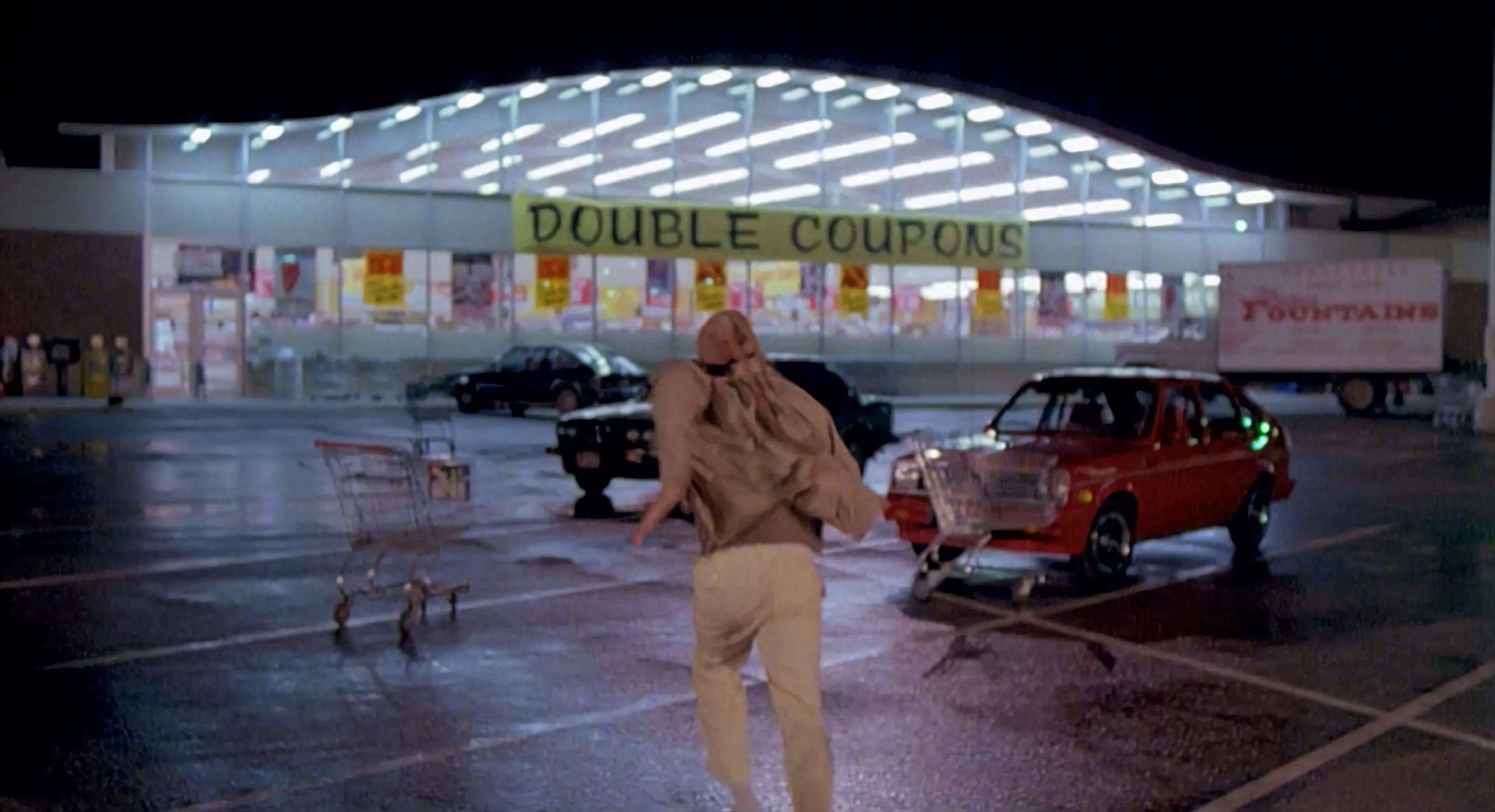
The exterior of the Double Coupons market was filmed in Mesa.
Circle Films/20th Century Fox
Double Coupons Supermarket
827 East Main Street, Mesa
So did the management of a now-defunct grocery store at Horne and Main streets in Mesa where more chase footage was shot. Production shot at the supermarket over several nights and upgraded its lighting for filming, Field says.
“It was more daylight-balanced, which looked better on film,” he says. “When we went to change it back [store management] told us to they preferred it and wanted it to be kept in place. It was the least we could do after having people shooting guns and having dogs run around in the market.”
Hoy remembers spending long hours working as PA at the store, including chastising Cage for some unseemly behavior.
“There was a huge barrel of bulk sunflower seeds at the market and between takes, Nic would eat the seeds and throw the shells back in,” she says. “And I’m like, ‘That’s kind of gross, man.’ He just went, ‘They’re worth more now.'”
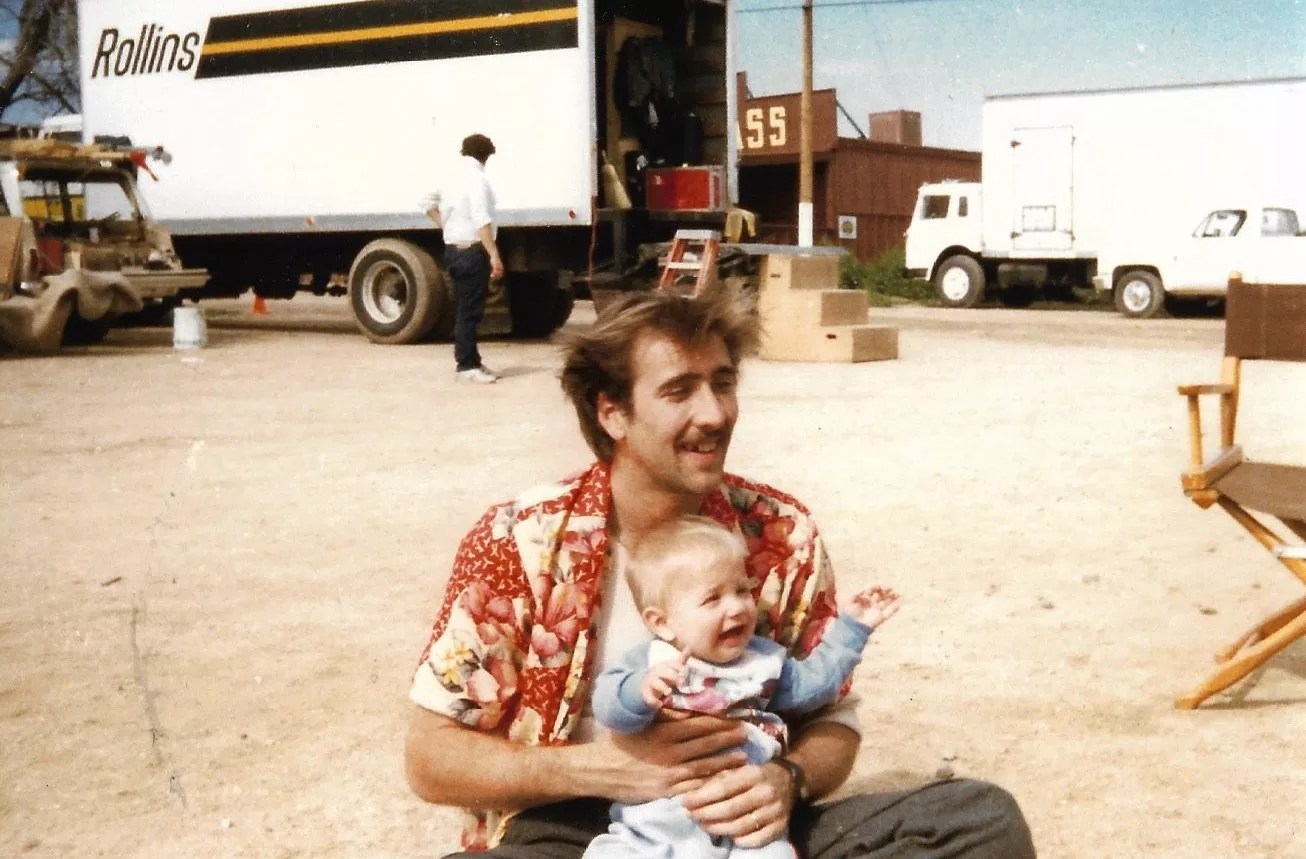
Nicolas Cage holding TJ Kuhn behind the scenes at Reata Pass Steakhouse in Scottsdale.
Courtesy of Julie Asch Kareus
Reata Pass Steakhouse
27500 North Alma School Parkway
“Gimme that baby, you warthog from hell!”
The now-demolished Reata Pass Steakhouse in north Scottsdale was the epicenter of the Raising Arizona production. Hoy says base camp was located there, it was within the vicinity of a few other shooting locations, and driving scenes were shot along the nearby Jomax and Dynamite roads.
“They’d pull out the camera car [and] process trailer onto Jomax and then shoot up and down all day long filming,” she says.
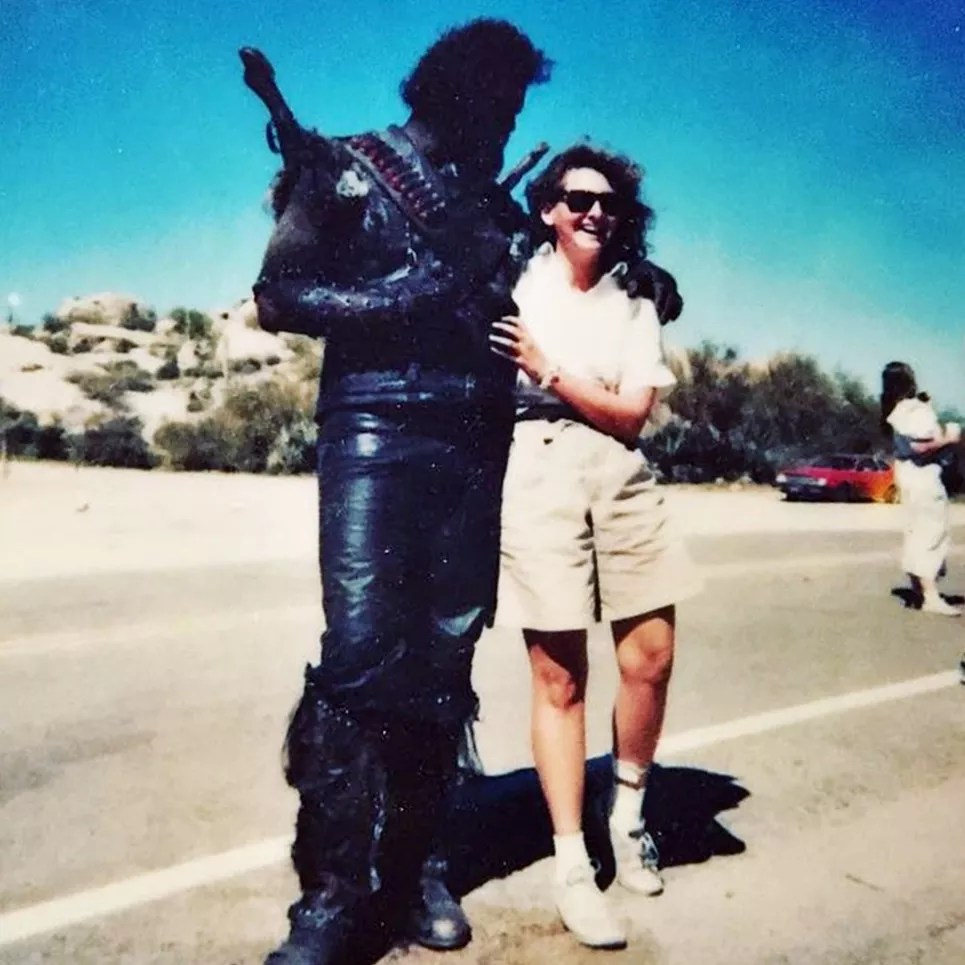
Linette Shorr with Randall “Tex” Cobb.
Linette Shorr
Reata Pass, which was demolished in 2015 after closing three years prior, is also where Hi and Ed squared off with biker/bounty hunter Leonard Smalls in the movie’s climax.
“We spent lots of days out there,” Field says. “The whole fight of Tex Cobb and H.I. McDunnough, the climax of the movie, that was all out at Reata Pass.”
Shorr has plenty of memories of her experiences helping set up those scenes. “That was a huge thing because that involved cars. So all those cars that [Cage] crawls under, one is my VW bug, another is one of my friend’s cars,” Shorr says. “I was ecstatic because I got my best friend’s cars in the movie. So they made like $100.”
She also has a prized photo of her with actor Randall “Tex” Cobb, who was covered in black gook for the film’s final scenes.
“It’s from that day because he was totally into me and kept bugging me all the time,” she says.
Cobb’s look, as well as his various tattoos and nasty teeth, were done on the film by makeup artist Katherine James, who got her start on Raising Arizona.
“It was my first, but probably the most fun I’ve ever had making a movie,” says James, who has since gone on to a full-time career in Hollywood and worked as Holly Hunter’s makeup artist for years.
She also helped created Cage’s various wounds from his battle with Smalls and also “dirtied everyone up.”
“The funny thing about making people dirty is that it’s hard to keep them dirty. You would think if you made somebody dirty, they would stay dirty all day,” she says. “That’s the kind of makeup you chase all the time because it keeps wiping off. It doesn’t matter what you use. You’re outside. It’s 90 degrees. People sweat. It keeps coming off, so trying to keep him dirty was quite the task.”
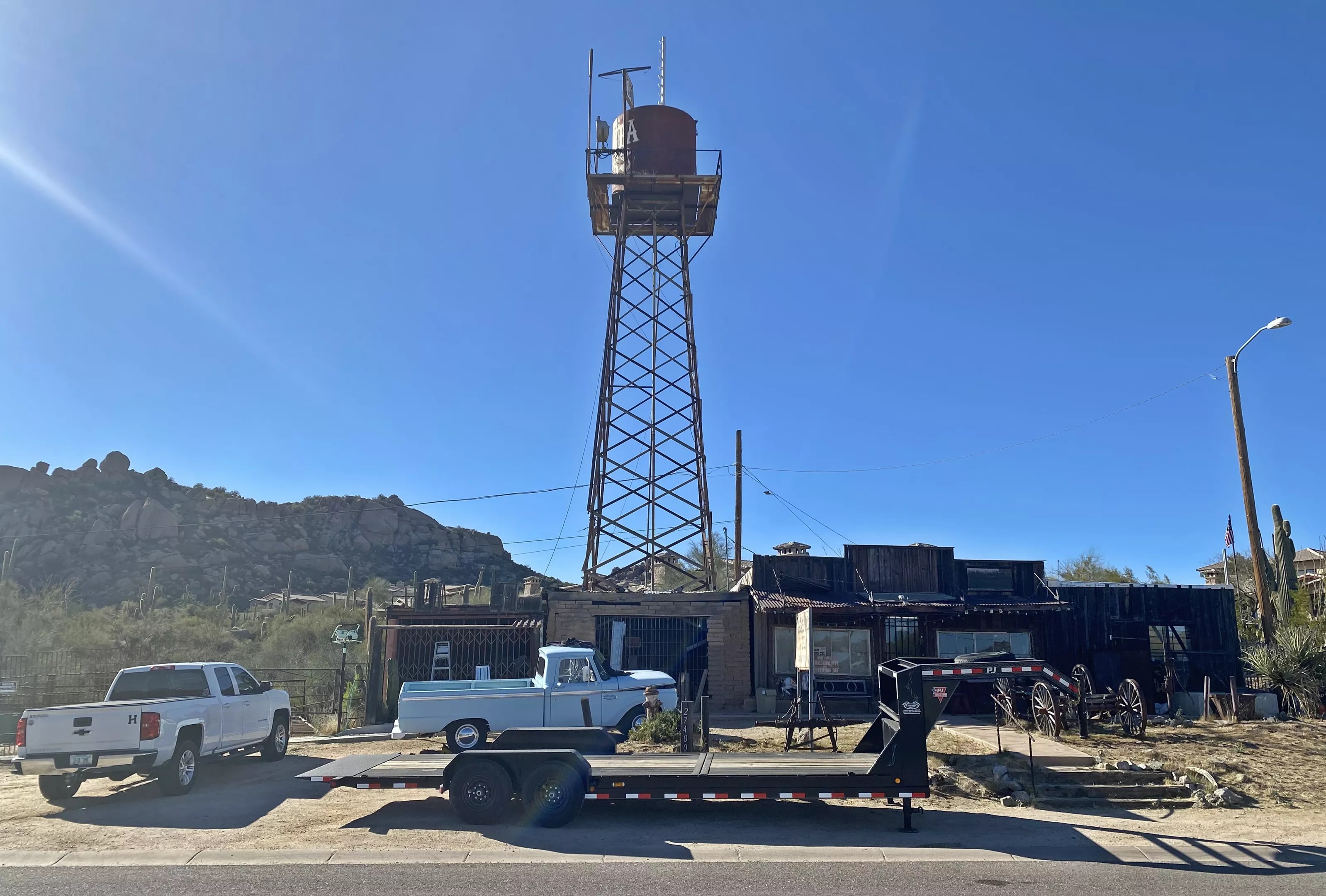
The only thing that remains of the Reata Pass in Scottsdale.
Benjamin Leatherman
There’s not much of Reata Pass left these days, save for its giant water tower along Alma School Road, which is frequently photographed by fans of the movie reenacting Cage’s leap away from the explosion that (spoiler alert) kills Smalls. Field, who lives and works in L.A. says he visits there when he’s in the Valley.
“It’s such a great location,” he says. “There will always be these memories of that whole area years ago on the film.”
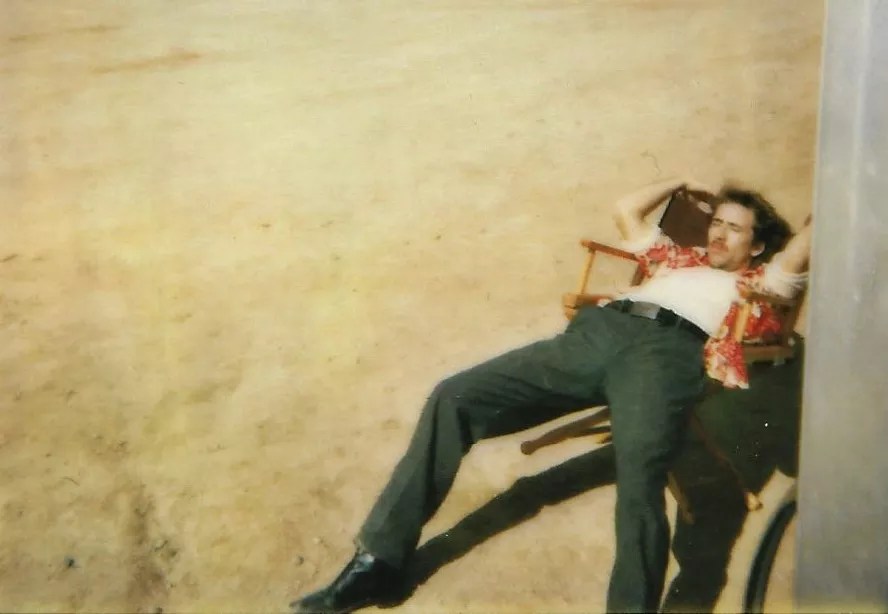
Nicolas Cage relaxing behind the scenes of Raising Arizona.
Courtesy of Julie Asch Kareus
Denouement
“I dreamt I was as light as the ether, a floating spirit visiting things to come …”
James says working on Raising Arizona helped propel her in Hollywood.
“In some way, I can almost connect a lot of stuff I did,” she says. “Because I did Raising Arizona, the next movie the costume designer [Richard Hornung] brought me to New York to work on a little movie there. Then I did Miller’s Crossing.”
Shorr got a similar career boost from working with the Coen brothers.
“It changed my whole life,” she says. “Everyone on that job was like, ‘You should come to New York.” And I got a job through somebody on [Raising Arizona] recommending me. And I flew to New York and I knew nobody or nothing. And I then worked on The Equalizer as an art department coordinator. And then I went to Saturday Night Live.
“I mean, my whole career started from that movie,” Shorr says. “I learned every a lot from them and I still get jobs because of that job.”